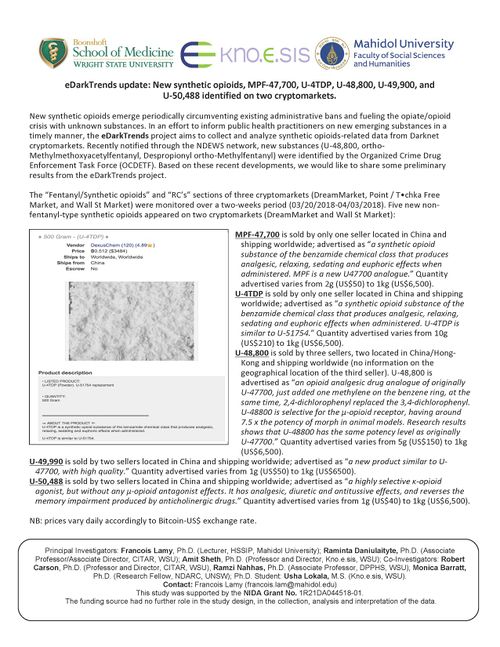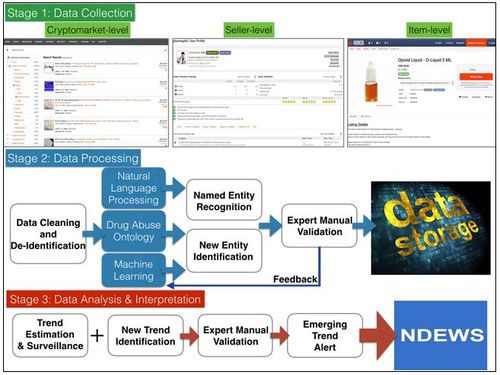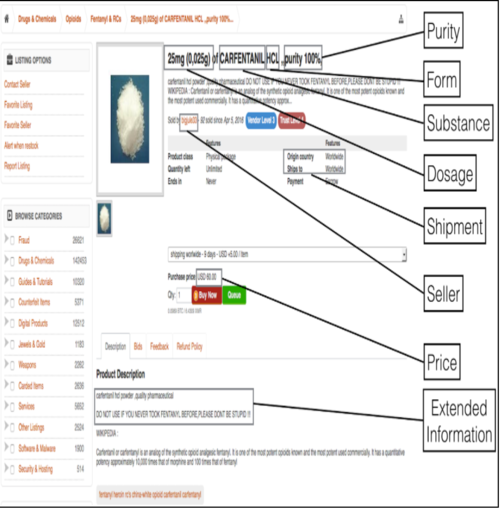Public Health Addictions Research at AIISC
Addictions Research being conducted at Artificial Intelligence Institute at Univeristy of South Carolina (AIISC) includes the below works:
Contents
- 1 Public Health, Epidemiology, Addictions x Social Media & AI Slides
- 2 Drug Abuse Ontology
- 3 Cannabis Addictions Research - EDrug Trends
- 4 Opioids Addcitions Research - Edark Trends
- 5 People
- 6 Publications
- 7 Social Media
- 8 Contact
- 9 Overview
- 10 Research Innovation
- 11 Specific Aims
- 12 Concurrent Projects at Kno.e.sis
- 13 Prior relevant Projects
Public Health, Epidemiology, Addictions x Social Media & AI Slides
Please see our ARC Talk (Nov 11, 2020) slides for Overall picture of our Addictions work.
Drug Abuse Ontology
Please see here for our work on Drug Abuse Ontology.
Cannabis Addictions Research - EDrug Trends
eDrugTrends is an inter-disciplinary project between the AIISC formerly known as Ohio Center of Excellence in Knowledge-enabled Computing (Kno.e.sis) and the Center for Interventions, Treatment and Addictions Research (CITAR) at Wright State University developed to monitor cannabis and synthetic cannabinoid use.
Please see here for our work on Cannabis-related Addictions Research
Opioids Addcitions Research - Edark Trends
eDarkTrends : Monitoring Cryptomarkets to Identify Emerging Trends of Illicit Synthetic Opioids Use is an inter-disciplinary project between the Ohio Center of Excellence in Knowledge-enabled Computing (Kno.e.sis) and the Center for Interventions, Treatment and Addictions Research (CITAR) at Wright State University developed to monitor illicit online transactions of several illicit synthetic opioids in dark web.
People
Principal Investigators: Francois Lamy , Amit P. Sheth, Raminta Daniulaityte
Co-Investigators:Robert Carlson, Ramzi Nahhas Dr. Barratt
Graduate Research Ph.D. Students: Usha Lokala
Software Engineers: Mike Partin
Publications
- Shweta Yadav, Joy Prakash Sain, Amit Sheth, Asif Ekbal, Sriparna Saha, Pushpak Bhattacharyya (2020) Assessing the Severity of Health States based on Social Media Posts 25th International Conference on Pattern Recognition (ICPR2020) - MiCo Milano Congress Center, ITALY 10 - 15 January 2021.
- Shweta Yadav, Usha Lokala, Raminta Daniulaityte, Krishnaprasad Thirunarayan, Francois Lamy, Amit Sheth (2020)" When they say weed causes depression, but it's your fav antidepressant": Knowledge-aware Attention Framework for Relationship Extraction submitted to PlosOne, arXiv preprint arXiv:2009.10155.
- Lamy, F. R., Daniulaityte, R., Barratt, M. J., Lokala, U., Sheth, A., & Carlson, R. G. (2020). Listed for sale: Analyzing data on fentanyl, fentanyl analogs and other novel synthetic opioids on one crypto market Drug and Alcohol Dependence, 213, 108115.
- Ramnath Kumar, Shweta Yadav, Raminta Daniulaityte, Francois Lamy, Krishnaprasad Thirunarayan, Usha Lokala, and Amit Sheth. 2020. eDarkFind: Unsupervised Multi-view Learning for Sybil Account Detection In Proceedings of The Web Conference 2020 (WWW ’20), April 20–24, 2020, Taipei, Taiwan.ACM, New York, NY, USA,11pages.
- Usha Lokala, Lamy, R. Daniulaityte, Amit Sheth, Ramzi W. Nahhas, Jason I. Roden, Shweta Yadav, and Robert G. Carlson. "Global trends, local harms: availability of fentanyl-type drugs on the dark web and accidental overdoses in Ohio." Computational and Mathematical Organization Theory (2019): 1-12.
- Webinar presented at NDEWS by R. Daniulaityte & Lamy on "Collecting and Analyzing Cryptomarket Data on Novel Synthetic Opioids"
- Lamy, R. Daniulaityte, Usha Lokala, Amit Sheth, Ugur Kursuncu, Ramzi W. Nahaas, Monica Barratt and Robert Carlson. "eDarkTrends: Analyzing Illicit Fentanyl and Other Novel Synthetic Opioid Trends on Cryptomarkets", College on Problems of Drug Dependence (CPDD) 2019.
- Manas Gaur, Ugur Kursuncu, Alambo A, Amit Sheth, Raminta Daniulaityte, Krishnaprasad Thirunarayan, Jyotishman Pathak. "Let Me Tell You About Your Mental Health!" Contextualized Classification of Reddit Posts to DSM-5 for Web-based Intervention. In The 27th ACM International Conference on Information and Knowledge Management (CIKM’18). Torino, Italy: Association for Computing Machinery; 2018 [1].
- Kho, S. J., Padhee, S., Bajaj, G.,Thirunarayan, K., & Sheth, A. (2019). Domain-specific Use Cases for Knowledge-enabled Social Media Analysis. In Emerging Research Challenges and Opportunities in Computational Social Network Analysis and Mining (pp. 233-246). Springer, Cham.
- Ugur Kursuncu, Manas Gaur,Usha Lokala,Krishnaprasad Thirunarayan,Amit Sheth and I. Budak Arpinar. "Predictive Analysis on Twitter: Techniques and Applications". Book Chapter in "Emerging Research Challenges and Opportunities in Computational Social Network Analysis and Mining", Editor: Nitin Agarwal, Springer, 2018.
- R. Daniulaityte, R. Carlson, F. Golroo, S. Wijeratne, E. Boyer, S. Martins, R. Nahhas, A. Sheth. 'Time for dabs': Analyzing Twitter data on butane hash oil use. The College on Problems of Drug Dependence CPDD 2015, Phoenix, Arizona, June 13-18, 2015.
- R. Daniulaityte, Ramzi W. Nahhas, S. Wijeratne, R. Carlson, F. Lamy, S. Martins, E. Boyer, G. A. Smith, Amit Sheth, "Time for dabs": Analyzing Twitter data on marijuana concentrates across the U.S., Drug and Alcohol Dependence, Volume 155, 1 October 2015, Pages 307-311, ISSN 0376-8716, http://dx.doi.org/10.1016/j.drugalcdep.2015.07.1199.
- S. Wijeratne, L. Balasuriya, A. Sheth, Derek Doran, EmojiNet: Building a Machine Readable Sense Inventory for Emoji, In 8th International Conference on Social Informatics (SocInfo 2016) Bellevue, WA, USA, 2016.
- S. Wijeratne, L. Balasuriya, A. Sheth, D. Doran, EmojiNet: A Machine Readable Emoji Sense Inventory, Wright Brother's Day, Wright State University. Dayton, Ohio, USA, 2016.
- R. Daniulaityte, L. Chen, F. Lamy, R. Carlson, K. Thirunarayan, A. Sheth. “When ‘Bad’ is ‘Good’”: Identifying Personal Communication and Sentiment in Drug-Related Tweets. JMIR Public Health Surveillance 2016;2(2):e162. DOI: 10.2196/publichealth.6327
- F. Lamy, R. Daniulaityte, A. Sheth, R. Nahhas, S. Martins, E. Boyer. “Those edibles hit hard”: exploration of Twitter data on cannabis edibles in the U.S. Drug Alcohol Dependence. Drug Alcohol Dependence. 2016;164:64-70. DOI: 10.1016/j.drugalcdep.2016.04.029.
- Sanjaya Wijeratne, Lakshika Balasuriya, Amit Sheth, Derek Doran, A Semantics-Based Measure of Emoji Similarity, In 2017 IEEE/WIC/ACM International Conference on Web Intelligence (WI). Leipzig, Germany; 2017. Demo
- Sanjaya Wijeratne, Lakshika Balasuriya, Amit Sheth, Derek Doran, EmojiNet: An Open Service and API for Emoji Sense Discovery, In 11th International AAAI Conference on Web and Social Media (ICWSM 2017). Montreal, Canada; 2017. Demo | BibTeX
Social Media
Join us on AIISC Public Health
Contact
Contact Usha Lokala Email: nlokala@email.sc.edu LinkedIn AIISC Public Health Addictions
Overview
The cause of this project is to design effective and responsive prevention and policy measures as public health professionals require timely and reliable information on trends in illicit synthetic opioid supply and availability. Monitoring cryptomarkets offers a valuable source of information for epidemiological surveillance by providing timely data regarding emerging substances and product form (e.g., powder, e-liquid). However, the frequent introduction of unclassified molecules combined with the opacity of cryptomarkets constitutes a challenge for traditional epidemiological surveillance systems. The National Forensic Laboratory Information System (NFLIS) provides crucial information about drugs seized by law enforcement across the U.S, but it is time lagged. The National Drug Early Warning System (NDEWS) collects timely data from sentinel sites and social media sources, but it is limited to data as displayed on the public side of the "Surface" Web. Prior studies, as well as several governmental agencies, have monitored the Surface Web to identify emerging cryptomarkets to evaluate volumes of substances being supplied, drug prices, number of sellers, seller revenue, number of cryptomarkets, and country specifics. However, there is no epidemiological surveillance system based on cryptomarket data that is oriented toward identifying emerging illicit synthetic opioids or monitoring changes in Darknet supply and marketing trends over time. Analysis of cryptomarket data could provide a powerful new tool for epidemiological surveillance enhancing the capacities of early warning systems to capture changes in the illicit synthetic opioid supply and availability.
Research Plan
The proposed study is multidisciplinary which builds on an existing, strong multidisciplinary collaboration integrating the fields of drug abuse research and computer sciences. This research answers why monitor illicit synthetic opiods in dark net cryptomarkets and why to employ advanced information processing techniques. The architecture and the sample data extracted is shown in Figure 1 and 2 respectively.
Research Innovation
The proposed study is highly innovative in the following ways: 1) eDarkTrends will be the first system to track and describe trends in illicit synthetic opioid supply and marketing on three cryptomarkets over a 20-month period for epidemiological monitoring and early warning network; 2) It will also be the first system created specifically for U.S-focused cryptomarket monitoring of illicit synthetic opioids supply and availability trends; 3) eDarkTrends proposes significant methodological innovation because it will be the first to develop and apply advanced information processing techniques for more rapid and efficient drug-related information extraction from cryptomarket data sources; 4) It will also be the first to develop and deploy computational information processing techniques to automatically identify emerging or previously unknown illicit synthetic opioid compounds or products forms as soon as they appear on cryptomarkets. Such computational techniques will bring significant innovation to web-based research in general because most prior methods were typically based on manual coding and lacked the ability to automatically identify yet unknown substances or known substances but emerging as substance of abuse, drug forms or drug combinations. It also has the potential to bring innovative methods to crawl cryptomarkets and advanced entity spotting techniques to Web-based research methods in other areas of public health.
Specific Aims
Submitted in response to PAR-16-055, the overall goals of this time-sensitive R21 are to harness cryptomarket data to conduct surveillance of the illicit synthetic opioid markets availability trends over time, and identify new substances as they emerge on cryptomarkets. The Specific Aims are to:
- Aim 1: Develop a semi-automated system, eDarkTrends, to collect and process data about illicit synthetic opioids supplied on cryptomarkets.
- Aim 2: Deploy eDarkTrends to:
- Aim 2.a: Describe and monitor U.S-based supply trends of illicit synthetic opioids on cryptomarkets (e.g., trends in availability of non-pharmaceutical fentanyl analogs, U-47700, MT-45), including types of illicit synthetic opioids, prices, advertised purity, dosage, product forms, quantity supplied, and drug combinations;
- Aim 2.b: Identify new illicit synthetic opioid substances and product forms soon after they appear on cryptomarkets.
Funding
|
Concurrent Projects at Kno.e.sis
- Innovative NIDA National Early Warning Sysetm Network (iN3)
- Modeling Social Behavior for Healthcare Utilization in Depression
- Context-Aware Harassment Detection on Social Media
- Hazards SEES: Social and Physical Sensing Enabled Decision Support
- Market Driven Innovations and Scaling up of Twitris
- Project Safe Neighborhood: Westwood Partnership to Prevent Juvenile Repeat Offenders
- MIDAS
- Market Driven Innovations and Scaling up of Twitris
- kHealth: Semantic Multisensory Mobile Approach to Personalized Asthma Care


